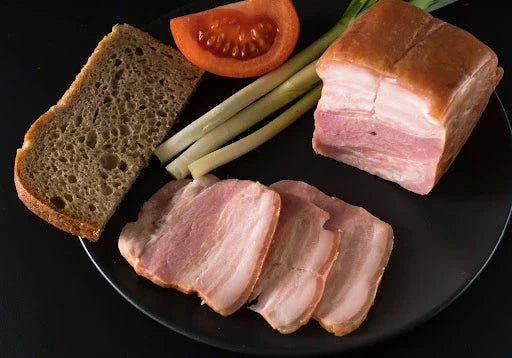
Salo: The Perfect Snack with This Simple Russian Recipe
Teilen
When most people think of traditional Russian cuisine, dishes like borscht or beef stroganoff might come to mind. However, there's one beloved delicacy that holds a special place in Eastern European hearts and homes: salo. This extraordinary yet straightforward snack represents generations of culinary tradition, transforming humble pork fat into something truly magnificent. Far from being just another appetizer, salo embodies the essence of Russian hospitality and the art of preserving food with minimal ingredients and maximum flavor.
The beauty of salo lies not in its complexity, but in its profound simplicity. This traditional treat has sustained families through harsh winters and celebrated countless gatherings with friends. Whether served alongside dark rye bread, crisp pickles, or sharp onions, salo creates an authentic taste experience that connects modern food lovers with centuries-old traditions. The transformation from raw pork fat to this cherished delicacy requires nothing more than patience, quality ingredients, and respect for time-honored techniques.

What is Salo and why is it So Popular?
Salo represents one of the most iconic elements of Russian and Eastern European cuisine. At its core, salo is cured pork fat, typically including the skin, that undergoes a careful preservation process using salt and various seasonings. This traditional preparation method has been passed down through generations, creating a snack that's both nutritious and incredibly flavorful.
The historical significance of salo cannot be overstated. In regions where winters were long and harsh, preserving meat and fat was essential for survival. Families developed methods to cure pork fat that would keep for months without refrigeration, providing a reliable source of calories and nutrients during difficult times. This Russian salo recipe became more than just food preservation; it evolved into a cultural cornerstone that brought families together around the dining table.
Beyond its practical origins, salo has maintained its popularity due to its unique taste profile and versatility. The curing process creates layers of flavor that range from subtly salty to richly savory, depending on the specific seasonings used. Modern food enthusiasts appreciate salo for its authentic taste and the connection it provides to traditional cooking methods that prioritize quality ingredients over complicated preparations.
The Basic Salo Recipe - Simple and Authentic
Creating authentic salo at home requires surprisingly few ingredients, but the quality of each component makes a significant difference in the final result. The foundation of any good salo rezept begins with selecting the proper cut of pork fat, preferably with skin attached, from a reputable butcher or specialty market.
Essential Ingredients for Traditional Salo

The ingredients needed for this classic salo recipe are refreshingly straightforward:
- Fresh pork fat with skin (approximately 2-3 pounds)
- Coarse sea salt or kosher salt (about 1 cup)
- Fresh black peppercorns (2 tablespoons, coarsely ground)
- Fresh garlic cloves (4-6 cloves, minced)
- Bay leaves (6-8 leaves)
- Optional herbs such as dill, caraway seeds, or paprika
Step-by-Step Preparation Method
The preparation process for this traditional Russian salo recipe follows a methodical approach that ensures proper curing and flavor development. Begin by thoroughly cleaning the pork fat and patting it completely dry with paper towels. Any moisture remaining on the surface can interfere with the curing process and potentially lead to spoilage.
Create the curing mixture by combining the coarse salt with ground black pepper, minced garlic, and crumbled bay leaves. This aromatic blend will penetrate the fat during the curing period, infusing it with the characteristic flavors that make salo so distinctive. Some recipes call for additional spices, but the basic combination provides an excellent foundation for first-time makers.
Coat the entire piece of pork fat with the salt mixture, ensuring every surface is thoroughly covered. The salt draws out moisture while the seasonings penetrate the fat, beginning the transformation process. Wrap the seasoned fat tightly in cheesecloth or clean kitchen towels, then place it in the refrigerator for the curing period.
Curing Time and Storage Considerations
The curing process typically requires 7-10 days for optimal flavor development, though some traditionalists prefer longer curing periods of up to two weeks. During this time, the salt continues working to preserve the fat while the seasonings deepen and meld together. Check the salo every few days, rewrapping it in fresh cloth if necessary.
Adding Flavors to Elevate Your Salo Snack
While traditional salo is exceptional on its own, many home cooks enjoy experimenting with additional seasonings and flavor profiles. The basic salo rezept serves as an excellent foundation for creative variations that can suit different taste preferences and occasions.
Popular Seasoning Variations

Regional variations of salo incorporate local herbs and spices that reflect the culinary traditions of different areas. Some popular additions include:
- Caraway seeds for a slightly sweet, aromatic note
- Sweet or smoked paprika for depth and color
- Fresh dill and fennel seeds for a bright, herbaceous quality
- Juniper berries for a subtle pine-like flavor
- Red pepper flakes for those who enjoy a gentle heat
Modern Serving Suggestions
Contemporary presentations of salo often incorporate elements that complement its rich, salty character while adding textural contrast and visual appeal. Consider serving thin slices on dark rye bread with pickled vegetables, or creating an elegant appetizer board featuring salo alongside aged cheeses, preserved vegetables, and artisanal crackers.
Serving Salo as the Perfect Snack
The traditional approach to serving salo emphasizes simplicity and allows the preserved fat to shine as the centerpiece of the experience. Slice the cured salo into thin pieces, revealing the beautiful layers created during the curing process.
Classic Accompaniments
The most authentic way to enjoy salo involves pairing it with complementary foods that enhance rather than mask its distinctive flavor:
- Fresh dark rye or pumpernickel bread
- Thinly sliced sweet or red onions
- Pickled cucumbers, tomatoes, or mixed vegetables
- A shot of quality vodka or other clear spirits
- Coarse mustard or horseradish for added zing
Creating the Perfect Salo Experience
The key to serving exceptional salo lies in temperature and presentation. Remove the cured fat from refrigerator about 30 minutes before serving, allowing it to come closer to room temperature. This slight warming enhances the flavors and makes slicing easier while maintaining the proper texture.
Arrange thin slices on a wooden cutting board or traditional serving platter, accompanied by the classic sides mentioned above. The contrast between the rich, salty salo and the sharp bite of onions or the acidic crunch of pickles creates a balanced flavor profile that has satisfied appetites for generations.
Conclusion
This traditional Russian salo recipe offers home cooks an authentic connection to Russian culinary heritage while creating a distinctive snack that's perfect for entertaining or personal enjoyment. The simplicity of the preparation process makes it accessible to cooks of all skill levels, while the depth of flavor achieved through proper curing techniques ensures impressive results.
The beauty of making salo at home extends beyond the final product itself. This time-honored preservation method connects modern kitchens with centuries of culinary wisdom, transforming basic ingredients into something truly special. Whether served at casual gatherings or special occasions, homemade salo represents the best of traditional cooking: simple ingredients, careful technique, and patience rewarded with exceptional flavor.
Try this authentic recipe in your own kitchen and discover why salo continues to hold such an important place in Eastern European cuisine. The process may require patience, but the results justify every moment spent waiting for the perfect cure

